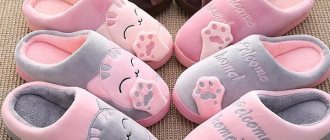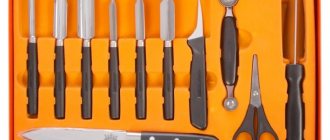Principles of convenient storage of clothes in a closet, drawer, chest of drawers, on a hanger
Keeping your closet in order ensures better preservation of things, saves time and space. To avoid chaos, it is better to adhere to certain rules, the effectiveness of which has been proven in practice.
To avoid clutter, hang everything in its place
Here are some tips and ideas for organizing your clothes and cleaning out your closet. Before establishing a beautiful order, they get rid of unnecessary things.
It is better to throw out clothes with stains, holes and damage and take them to the dacha.
Wardrobe items in good condition, but which have become too small or will not be worn for other reasons, can be donated to a charity.
The remaining things are grouped according to the following characteristics:
- Type. The simplest and most convenient way to store things. The principle is simple - separate shelves or spaces for dresses, skirts, T-shirts, trousers, towels, bed linen. This organization eliminates long searches for the right thing.
Things can be sorted by type: dresses with dresses, trousers with trousers. - By belonging to a family member. Separating shelves or departments for each family member. If the closet is small, then you can purchase multi-colored hangers. Red for mom, blue for dad, yellow for baby.
Accommodation depending on family member - By color. This is the arrangement of clothing items by color. Relevant for people with an extensive wardrobe who regularly select a set of clothes by color.
Storage by color - By appointment. In this case, clothes are sorted by situation: for work, special occasions, leisure, sports, etc.
Intended storage
Despite the fact that all closets have different internal organization, the comfortable principle of arranging things is the same. A prerequisite is division by season. Clothes for the current season should be placed in an accessible place, and clothing for the past season should be placed on mezzanines or upper shelves.
Only clean or ventilated clothes are placed in the closet.
You shouldn’t pack departments tightly, hang several items of clothing on one hanger at once, or pack things in drawers. This interferes with ventilation and leads to the formation of an unpleasant odor.
It is better to place heavy things and shoes at the very bottom. Everyday items are placed in the center at eye level and in a place convenient for reaching. T-shirts, underwear, towels and bedding sets are stored separately from outerwear.
General rules for caring for clothes
When caring for textiles, you must follow the general recommendations:
- select washing, spinning and drying modes strictly based on the information on the label;
- observe temperature conditions when washing, drying and ironing;
- do not twist the products when spinning;
- If worn infrequently, store clothes folded, as using hangers leads to deformation.
Choose your own washing modes for different fabrics.
To maintain the shape of items after washing, they must be rolled up in a towel and wrung out.
Features of care largely depend on the type of fabric:
- Knitwear. Products made from it must be washed inside out and using soft detergents. Dry on a horizontal surface. Do not use hangers.
- Cashmere. Wash only by hand, with delicate detergent. Do not hang to dry.
- Wool. Wash with mild detergents. Dry flat.
- Cotton. Use special detergents to wash colored items. Can be dried in a dryer. Iron from the wrong side using an iron with a humidifier.
- Linen. Be careful about the washing temperature, as if you choose the wrong one, things can shrink. Iron using an iron with a damper.
- Silk. Wash preferably by hand using delicate detergents. Dry away from sunlight and heating devices. Iron from reverse side without using steam. Avoid contact with perfume, deodorant and sweat as they may cause the fabric to fade.
- Viscose. Wash with mild detergents.
- Modal. Products made from this fabric remain soft after washing, do not fade or shrink, so to care for them, just follow the label.
- Acrylic. Ironing is only permitted if there are instructions on the label.
- Polyester. Wash colored items using appropriate detergents. Iron from the wrong side.
- Nylon. Ironing is usually not required.
- Neoprene. Wash by hand in warm water with mild detergents. Rinse the front and back sides separately. Ironing is prohibited.
Different types of fabrics have their own washing rules that must be followed.
To determine how to organize your closet, you need to take into account your own preferences. Only a closet that is convenient to use will be clean and organized, and therefore you need to arrange things exclusively for yourself.
How to properly organize things, ideas on how to compactly place things and free up space
Almost all dresses are hung on hangers. The exception is knitted and knitted items. Dresses made of silk or other thin materials are hung on hangers covered with fabric. For dresses made of dense and non-stretchable fabrics, wooden hangers are suitable. For evening models with a complex cut, it is better to purchase hangers with additional fasteners. Since they are rarely worn, they can be covered and stored in the back corner of the closet.
Seasonal clothes and items that are rarely used are best stored in covers.
Jackets and jackets are hung on wooden hangers with rounded ends so as not to deform the shoulder lines. Before this, all contents are removed from the pockets.
Store jackets and coats on hangers with hangers
It is practical to hang skirts and trousers on hangers with special clips. Skirts are fastened to the belt, trousers also or to the bottom of the legs. To save space, purchase multi-tiered hangers; you can hang 4-5 things on them at once.
It is convenient to store fireboxes on special hangers that can hold up to 5 pieces at once
Jeans are easy to store. They can be turned inside out, stacked or rolled and given a separate shelf for them.
T-shirts, T-shirts, summer turtlenecks are stacked in piles of 5-6 pieces.
If space in the closet allows, you can hang it on trouser hangers.
Men's shirts are hung on thin hangers and can be placed next to their trousers.
Knitted and woolen sweaters and jackets are not hung on hangers. This leads to stretching and loss of shape of the product.
They are stacked and placed on shelves. To ensure that the fibers retain their elasticity, items made from light and fluffy pile are placed on top of the pile. It is better not to stack more than three heavy woolen sweaters in one pile - the pile can become very wrinkled. To ventilate the products, tissue paper is placed between them.
Sweaters and turtlenecks are stored in neat piles
It is better to store underwear in drawers. If you don’t have them in your closet, you can purchase organizers with small compartments. The laundry will retain a pleasant smell if you put a natural fragrance in the drawer.
Tights, socks and stockings are also stored in drawers. Cases with compartments for each pair allow you to quickly find the item you need, but take up more space.
It is better to put underwear and socks in separate drawers
Accessories - ties, neckerchiefs, scarves, belts and belts are best placed in a compartment with a hanger bar. This way they will always be ready to use. To do this, you can purchase special hangers and allocate space on the side wall of the closet. Another option is to roll things up and place them in an organizer.
For ties and scarves you can purchase a special hanger
Getting rid of unnecessary things
Once your wardrobe has been sorted into seasonal piles, it’s time to take a closer look at them and divide them into several categories:
- good things that are worn all the time;
- stretched, out of shape or damaged;
- decent clothes that you don’t wear for some reason.
Everything is clear with the first category. These clothes must be inspected if you need to send some of them for washing, and put the rest in the closet.
If an item has lost its original appearance: the sweater is all in pills, the knees are stretched out on the trousers, it should be put in a heap to be thrown away. You should also send faded or torn clothes there. You can safely take this pile to the trash heap and not regret it, since these things will not be able to decorate you either at home, or on a hike, or at the dacha.
The last category is what you don't wear. Perhaps the clothes became small or there was nothing to wear them with, or they were bought at a huge discount, but were not useful. We also need to get rid of this. Determine a period, for example a year, to cover the entire season, and feel free to throw out those that have not been worn during this time. Items of good quality, but not the right size, can be given to a friend or acquaintance. If it’s a pity to throw them away, you can give them to charity: take them to church or volunteers. They will find use there.
Clothes that are out of fashion should also not be left in the closet under the pretext that “fashion is coming back.” Cyclicity does exist, but only the general direction is preserved. And things, after lying around for several decades, can turn yellow and deteriorate.
Related article: How to clean polyurethane foam from a metal door: special products
If after these manipulations there are still too many things, try to sort them according to “need”. Look carefully, perhaps you have 3 shirts of the same color or a pair of identical jumpers? Then you should keep what fits better with the rest of your wardrobe and get rid of others.
We do the same with shoes. When your favorite boots have faded, you can paint them. However, if they have lost their shape or are badly torn, it is better to throw them away and buy new ones.
Important! You should get rid of the habit of moving unnecessary things from one place to another. For a dacha or vegetable garden it can be useful during repairs, you need to forget about it once and for all. Even in the garden you should not look like a scarecrow.
Sorting
First of all, let's start by sorting things, as this method will help you quickly find the clothes you need. So let's start our list of ideas.
1. Distribute clothes from left to right - hanging items in descending order of length will help separate shirts from dresses, and jackets from T-shirts.
2. Clothes by type - differentiate items by type: T-shirts, shorts and T-shirts, and preferably by color. This way you'll find your favorite T-shirts in no time.
3. Seasonal suits - carry out a strict organization of winter and summer clothes so that your winter coat does not come to hand in the summer.
4. Vertical stacks – Store small items vertically rather than horizontally. In the future, you can easily remove the T-shirt from the middle of your underwear.
5. Don't fill the shelves to capacity - if you put all your clothes back to back, it will be more difficult for you to get the things you need.
6. Use boxes and dividers - this idea will allow you to store socks, underwear or sewing items separately. It is very convenient if you use a hanging organizer.
7. Identification marks - place small stickers on closed boxes of things and write on each one what exactly is there.
General recommendations
Design a closet or wardrobe from scratch to suit yourself and your needs. If you are yet to create storage space, design furniture or a dressing room to suit your own needs. Today you can easily create a project with any sections, shelves, hangers, cabinets, and so on. In such a place you can store not only things, but also a vacuum cleaner, ironing board, mop and other household supplies.
Be sure to get rid of the excess. This is the most important rule that will help you place things correctly and intelligently, even in a small space. Conduct an audit and go through everything that is in the apartment. Without regret, get rid of things that you have not used for a long time, broken items and items with defects.
Do an inspection and general cleaning before each new season. Feel free to get rid of clothes and shoes that don't fit, are broken or damaged. Get rid of products you haven't used for more than a year. After such cleaning, a lot of free space will appear. The article “How to get rid of unnecessary things in an apartment” will tell you how to quickly make an audit and where to donate what you don’t need.











